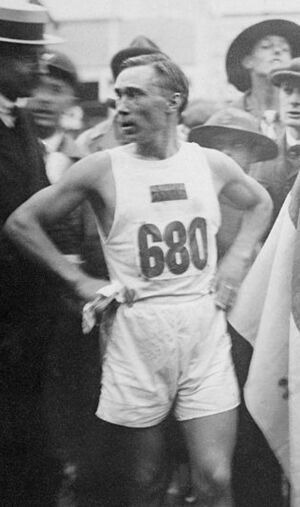Jüri Lossmann facts for kids

Jüri Lossmann at the 1920 Olympics
|
||||||||||||||
| Personal information | ||||||||||||||
|---|---|---|---|---|---|---|---|---|---|---|---|---|---|---|
| Born | 4 February 1891 Kabala, Governorate of Livonia |
|||||||||||||
| Died | 1 May 1984 (aged 93) Stockholm, Sweden |
|||||||||||||
| Height | 1.69 m | |||||||||||||
| Weight | 69 kg | |||||||||||||
| Sport | ||||||||||||||
| Sport | Athletics | |||||||||||||
| Event(s) | 10,000 m, marathon | |||||||||||||
| Club | Kalev Tallinn | |||||||||||||
| Achievements and titles | ||||||||||||||
| Personal best(s) | 10,000 m – 34:05.0 (1924) Marathon – 2:32:49 (1920) |
|||||||||||||
|
Medal record
|
||||||||||||||
Jüri Lossmann (born February 4, 1891 – died May 1, 1984) was a famous long-distance runner from Estonia. He is best known for winning a silver medal in the marathon at the 1920 Summer Olympics in Antwerp. He finished just 13 seconds behind the winner, Hannes Kolehmainen. Four years later, at the 1924 Summer Olympics in Paris, he proudly carried the flag for Estonia and finished tenth in the marathon race.
Life and Running Career
Jüri Lossmann started his sports journey playing football for a club called Merkur. Later, he switched to athletics, which is what we call track and field sports today.
Early Achievements
Lossmann was wounded during World War I, a very big war that happened many years ago. Luckily, he recovered and returned to running. In 1916, he won a marathon race in Tallinn, Estonia. He also won the Russian Championships in the 5000-meter race that same year.
In 1923, he won an important international marathon in Gothenburg, Sweden. A few years later, in 1928, he took part in the first part of the Trans-America Run, a very long relay race across the United States. The next year, he set a new Estonian record for how far someone could run in one hour. He also competed in another marathon in Antwerp.
Life Outside Running
Besides being a great runner, Lossmann also worked at the Estonian Chocolate Factory called Kawe. He worked there from 1922 to 1936. In the 1930s, he tried to coach other Estonian long-distance runners, sharing his knowledge and experience.
During World War II, Lossmann moved to Sweden for safety, just before Soviet troops arrived in Estonia. He had also trained as a jeweler earlier in his life. In Sweden, he used these skills and worked as a gold and silversmith. In 1964, he even made a special silver cup for Gustaf VI Adolf, who was the King of Sweden at the time. This gift showed thanks from the Estonian community living in Sweden.

